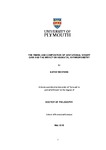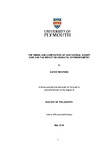The Timing and Composition of Gestational Weight Gain and the Impact on Neonatal Anthropometry
| dc.contributor.supervisor | Rees, Gail | |
| dc.contributor.author | Redfern, Kathy | |
| dc.contributor.other | Faculty of Health | en_US |
| dc.date.accessioned | 2018-08-03T11:46:27Z | |
| dc.date.issued | 2018 | |
| dc.identifier | 10074467 | en_US |
| dc.identifier.uri | http://hdl.handle.net/10026.1/11980 | |
| dc.description.abstract |
Background: Numerous maternal factors, such as body mass index (BMI), gestational weight gain (GWG), diet and physical activity (PA) have been shown to impact infant birth weight. In the UK, antenatal care tends to be based on pre-pregnancy BMI and women are not weighed routinely during pregnancy nor are there guidelines for GWG. However, it is widely acknowledged that maternal obesity and GWG in excess of the American Institute of Medicine guidelines are associated with increased risk of foetal macrosomia and recent studies have suggested a role of the timing and composition of GWG beyond that of BMI. The purpose of this study is to examine the effects of timing and composition of GWG on neonatal anthropometric outcomes in a prospective cohort study amongst women with a BMI≥30 kg/m2 in Plymouth, UK. Methods: Women (n=75) were recruited at 12 weeks gestation. Maternal height, weight and body composition assessed using skinfolds at biceps, triceps and subscapular were collected at baseline and repeated at 28 and 36 weeks gestation. Four-day food diaries and four days of accelerometry were collected in the days following each of the three study visits. Following delivery, infant weight and gestational age were obtained, and neonatal anthropometric measurements were recorded within 72 hours of delivery. Results: Maternal energy intake was positively associated with GWG and rate of fat mass (FM) accrual, in the second (r = 0.435 and r = 0.395, respectively, p<0.05) and third trimesters (r = 0.333 and r = 0.317, respectively, p<0.05), with no associations observed between maternal energy intake and rate of fat free mass (FFM) accrual in either trimester. Maternal rate of FFM accrual (in both trimester 2 and over total pregnancy), not FM nor rate of GWG, was positively associated with infant birth weight z scores (r = 0.360 and r = 468, respectively, p < 0.05) and upper arm area muscle estimate (UME) (r = 0.291 and r = 0.357, respectively, p < 0.05). Second trimester intake of sugar was positively associated with infant UME (r = 0.419, p<0.05), while third trimester intake of sugar was positively associated with both infant UME and infant birth weight z score (r = 0.376 and r = 0.308, respectively, p<0.05). Conclusion: The present study suggests that maternal accrual of FFM and intake of sugar during pregnancy may be associated with increased infant birth weight and lean mass. Further research is required to determine whether interventions should focus on changes in maternal body composition alongside diet and lifestyle during pregnancy, or if they should continue to focus on limiting total GWG. | en_US |
| dc.language.iso | en | |
| dc.publisher | University of Plymouth | |
| dc.rights | Attribution-NonCommercial-NoDerivs 3.0 United States | * |
| dc.rights.uri | http://creativecommons.org/licenses/by-nc-nd/3.0/us/ | * |
| dc.subject | Gestational weight gain | en_US |
| dc.subject | Pregnancy | en_US |
| dc.subject | Maternal body composition | en_US |
| dc.subject | Infant anthropometry | en_US |
| dc.subject | Diet | en_US |
| dc.subject | Birth weight | en_US |
| dc.subject.classification | PhD | en_US |
| dc.title | The Timing and Composition of Gestational Weight Gain and the Impact on Neonatal Anthropometry | en_US |
| dc.type | Thesis | |
| plymouth.version | non-publishable | en_US |
| dc.identifier.doi | http://dx.doi.org/10.24382/743 | |
| dc.type.qualification | Doctorate | en_US |
| rioxxterms.version | NA | |
| plymouth.orcid.id | 0000-0003-4885-493X | en_US |
Files in this item
This item appears in the following Collection(s)
-
01 Research Theses Main Collection
Research Theses Main




